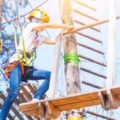Scaffolding is a critical component of construction and maintenance projects, providing access and support to workers at various heights. However, different environments present unique challenges that require specialized scaffolding solutions to ensure safety, efficiency, and productivity. This comprehensive guide explores different types of scaffolding tailored to specific environments, including indoor, outdoor, high-rise, confined spaces, and extreme weather conditions, offering insights into their features, benefits, and considerations.
Indoor Scaffolding:
Indoor construction projects often require scaffolding systems designed to navigate confined spaces, tight corridors, and limited access points. Indoor scaffolding must be compact, maneuverable, and lightweight while providing stable platforms for workers. Common types of indoor scaffolding include:
1. Mobile Scaffold Towers:
- Mobile scaffold towers are versatile and easy to move, making them suitable for indoor projects such as renovations, painting, and maintenance.
- Equipped with lockable casters, adjustable height platforms, and guardrails for enhanced safety and mobility.
2. Aerial Work Platforms (AWPs):
- AWPs, such as scissor lifts and boom lifts, provide elevated platforms for indoor tasks requiring access to high ceilings or structures.
- Electric or battery-powered options are available to minimize noise and emissions in indoor environments.
3. Cantilevered Scaffolding:
- Cantilevered scaffolding extends horizontally from a support structure, allowing access to areas where vertical supports are impractical.
- Ideal for indoor applications where space constraints limit traditional scaffold installation.
Outdoor Scaffolding:
Outdoor construction projects demand scaffolding systems capable of withstanding weather elements, uneven terrain, and variable site conditions. Outdoor scaffolding must be durable, stable, and weather-resistant to ensure worker safety and project efficiency. Common types of outdoor scaffolding include:
1. Tube and Coupler Scaffolding:
- Tube and coupler scaffolds are versatile and robust, suitable for outdoor applications such as building construction, renovations, and maintenance.
- Galvanized steel components provide corrosion resistance and durability in outdoor environments.
2. Frame Scaffolding:
- Prefabricated frame scaffolds offer easy assembly and disassembly for outdoor projects, providing stable platforms for workers.
- Reinforced joints and sturdy frames withstand external loads and environmental factors.
3. Suspended Scaffolding:
- Suspended scaffolds are commonly used for exterior facade work on high-rise buildings, bridges, and industrial structures.
- Rigging systems and safety measures ensure stability and worker safety at elevated heights.
High-rise Scaffolding:
High-rise construction projects present unique challenges due to the height and scale of the structures involved. High-rise scaffolding must be engineered, installed, and maintained to withstand wind loads, provide safe access, and ensure worker protection at extreme heights. Considerations for high-rise scaffolding include:
1. Structural Stability:
- High-rise scaffolding structures require careful engineering and analysis to withstand wind forces, vibrations, and dynamic loads.
- Structural calculations and reinforcement measures ensure stability and safety for workers and the surrounding environment.
2. Fall Protection:
- Fall protection systems, including guardrails, safety nets, and personal fall arrest systems, are essential for high-rise scaffolding to prevent accidents and injuries.
- Regular inspections and maintenance of fall protection equipment are critical to ensure compliance with safety standards.
3. Access and Egress:
- Safe access to and egress from high-rise scaffolding are crucial for worker safety and emergency evacuation procedures.
- Securely anchored ladders, stair towers, or hoist systems provide vertical movement on the scaffold structure.
Confined Space Scaffolding:
Confined spaces pose unique challenges for scaffolding installation and access due to limited entry points, restricted mobility, and potential hazards. Scaffolding for confined spaces must be customized to fit within tight spaces while providing safe working platforms for workers. Considerations for confined space scaffolding include:
1. Risk Assessment:
- Conduct a thorough risk assessment of the confined space environment to identify hazards and implement control measures.
- Factors such as air quality, ventilation, access points, and emergency rescue procedures must be considered during scaffolding planning and installation.
2. Customized Solutions:
- Design scaffolding systems tailored to the dimensions and constraints of the confined space, ensuring compatibility with existing structures and equipment.
- Modular and adjustable components allow for flexibility in scaffold configurations to meet varying confined space requirements.
3. Safety Precautions:
- Implement safety measures such as confined space entry permits, atmospheric monitoring, and emergency rescue plans to mitigate risks associated with confined space work.
- Provide comprehensive training and supervision for workers involved in confined space operations to ensure compliance with safety procedures.
Scaffolding for Extreme Weather Conditions:
Construction projects in regions prone to extreme weather conditions require scaffolding systems capable of withstanding harsh environments and protecting workers from the elements. Scaffolding for extreme weather conditions must be durable, weatherproof, and resilient to ensure worker safety and project continuity. Considerations for scaffolding in extreme weather conditions include:
1. Weatherproof Materials:
- Use weather-resistant materials such as galvanized steel, aluminum, and corrosion-resistant coatings to protect scaffolding components from deterioration and structural damage.
- Proper drainage and waterproofing measures prevent water accumulation and corrosion in scaffold structures.
2. Wind Load Calculations:
- Conduct wind load calculations and structural analysis to determine design requirements and reinforcement measures necessary to withstand high winds and windborne debris.
- Additional bracing, tie-downs, and anchorage systems enhance scaffold stability and resistance to wind forces.
3. Temperature Considerations:
- Consider the impact of temperature extremes on scaffolding materials, components, and worker comfort.
- Insulation, ventilation, and climate control measures help mitigate the effects of extreme heat or cold on scaffold structures and personnel.
Here are some FAQs about Scaffolding for Different Environments:
Erecting scaffolding in urban environments requires careful planning to minimize disruptions to pedestrian and vehicular traffic. Considerations include obtaining permits, scheduling work during off-peak hours, and implementing safety measures to protect workers and the public.
Scaffolding used in industrial environments must meet specific safety requirements and withstand harsh conditions such as high temperatures, chemical exposure, and heavy loads. Specialized materials and designs may be used to ensure durability and stability.
Scaffolding in marine environments faces challenges such as corrosion from saltwater exposure, dynamic loading from waves and currents, and limited access due to confined spaces or high elevations. Marine-grade materials and specialized designs are often required to meet these challenges.
Scaffolding used in historic or heritage sites must be designed to minimize damage to existing structures and preserve architectural integrity. Non-invasive anchoring methods, protective coverings, and skilled craftsmanship may be employed to ensure the safety of both workers and the site.
Scaffolding used in extreme weather conditions must be securely anchored and reinforced to withstand wind loads and prevent collapse. Waterproof coverings and anti-slip surfaces may be used to maintain safety and productivity in adverse weather.
Scaffolding used in environmentally sensitive areas must minimize disturbance to ecosystems and protect natural resources. Biodegradable materials, low-impact anchoring methods, and regular environmental monitoring may be employed to mitigate ecological impacts.
Scaffolding in confined spaces must be compact, lightweight, and adaptable to limited access points. Modular designs, adjustable components, and specialized safety measures may be utilized to ensure worker safety and facilitate efficient construction or maintenance tasks.
Conclusion:
Scaffolding for different environments requires careful planning, engineering, and implementation to ensure safety, efficiency, and productivity on construction projects. Whether indoors or outdoors, at great heights or in confined spaces, scaffolding systems must be tailored to meet specific requirements and challenges posed by each environment. By understanding the features, benefits, and considerations of various scaffolding types, stakeholders can select the most suitable solutions to achieve successful project outcomes while prioritizing worker safety and well-being.
References:
- Occupational Safety and Health Administration (OSHA). (2020). Scaffolding. Retrieved from https://www.osha.gov/scaffolding
- Scaffolding Awareness. Retrieved from https://cisrs.org.uk/scaffolding-awareness-training/






